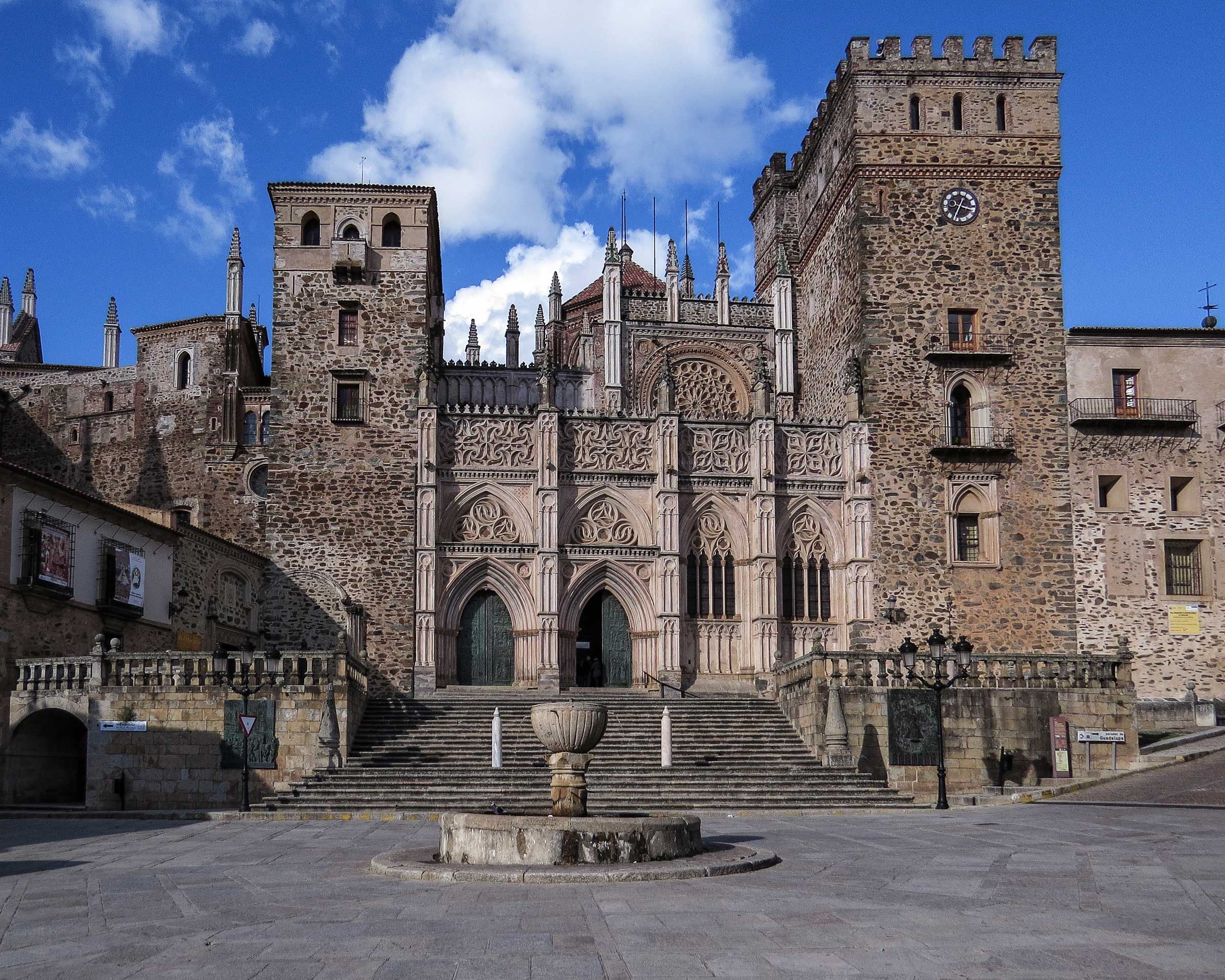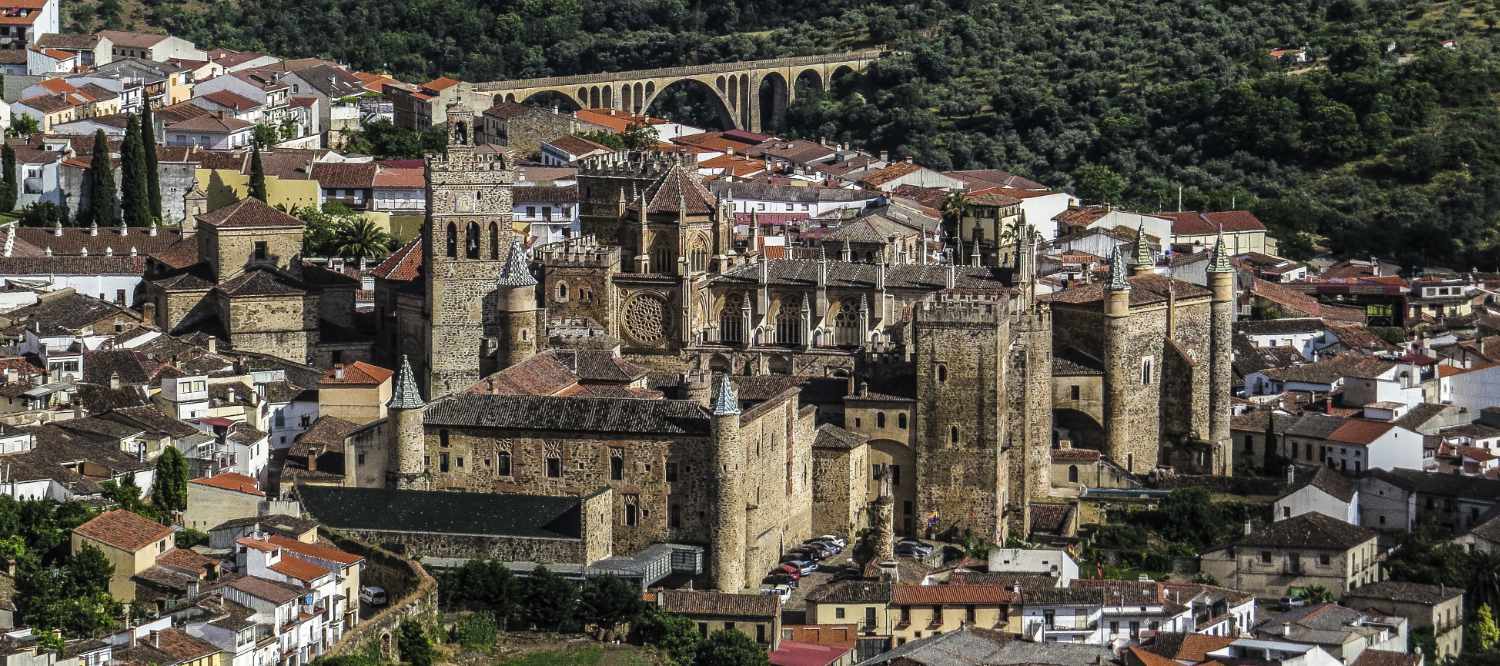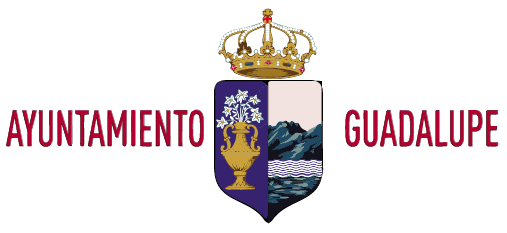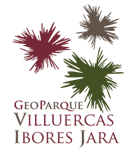Heritage
Royal Monastery
One of the best testimonies of the peninsular Mudejar declared a World Heritage Site by UNESCO in 1993. Superb and formidable monastic complex whose cultural, scientific and artistic evolution made it the busiest pilgrimage center of the ancient kingdom of Castile. The façade of the sanctuary was begun during the priory of Fernando Yáñez de Figueroa (15th century), at whose ends there are two towers, the Clock Tower on the right and the Porter’s Tower on the left. In this latter we can see the jambs and the lintel of its doorway, in which the medallions with the vase of lilies, emblem of the Virgin of Guadalupe and the arms of the kingdom of Castile stand out. This sanctuary and fortress at the same time mix different architectural styles: Gothic, Mudejar, Renaissance, Baroque and Neoclassical, which harmonize in an area that covers more than 20,000 square meters.

Arc of Dye
Of Mudejar influence and practically intact since its construction, it gave way to the old dye factories, one of the many guilds that existed in La Puebla de Guadalupe. It was part of the gates that closed the Alta and Baja towns in various places, giving the control population security and commerce and an image of a medieval fortress. Architecturally, it rests on two buttresses attached to adjacent houses, without residential architecture above, which sets it apart from the others.
Angel Fountain
16th century fountain. One of the 17 fountains that we can find in the urban area of Guadalupe. All of them with drinking water.
House of Gil Cordero
Various sources recognize this house as that of the shepherd from Cáceres to whom the Virgin appeared for the first time, at the end of the 13th century or the beginning of the 14th century, being entrusted with the task of building a modest hermitage to place her image. His body lies buried in the nave next to the sacristy of the monastery, the exact place where, according to tradition, the Romanesque carving appeared.

Arc of the Ages
Defending the southern end of the town and restored at the beginning of the century, it was the gateway for pilgrims and travelers coming from the south and the east. It was part of the second defensive belt, the one that surrounded the town. Both the arch and the upper house are built in stone and brick masonry.

Rupert Street
One of the main axes that links the Tres Chorros fountain and the Las Eras arch, under a typology of mountain architecture with an interior framework. It maintains the typical wooden arcades between the public area of the street and the private part of the house that protected from rain and sun, creating a space for commerce and to provide the necessary services to the growing flow of visitors and pilgrims. It is part of one of the most picturesque and well-known photographs of Guadalupe.

Three Jets Square
It is, along with the one in the main square, the most important fountain and one with the greatest urban significance. Around it and its square, the architectural fabric of Puebla Baja is articulated. This fountain, which dates from the 15th century, is today connected to the water supply network, but in the past it was connected to the network of sources of the Arca del Agua (one of the most important and unknown hydraulic works of the Middle Ages in the Iberian Peninsula. ), of which it was one of its main endings and thus appears reflected in the scheme of the medieval codex. Also one of the most typical and emblematic corners of Guadalupe.

Porticoed Houses
Picturesque set of traditional houses with two floors on chestnut wood beams. These arcades and bodies are found only in certain streets and squares, generally those immediately next to the entrance doors, and their origin is related to the protection of commercial activity linked to pilgrimages; shops, inns, wineries, apothecaries and other establishments. Also as a sign of hospitality and shelter for the hundreds of pilgrims who visited La Puebla and its Monastery.

Seville Arch
Another of the interior gates of the wall, together with the Chorro Gordo and San Pedro arches, closed the first defensive belt of the Monastery, created in the 16th century for security reasons given the massive influx of pilgrims and commercial activity in this area. ,. The floral decoration of its openings and the annexed set of popular architecture, gave this arch one of the most unique images of La Puebla. Before arriving there, we can see the houses of two famous people from Guadalupe. Don Gregorio López, famous jurisconsult, whose best-known work is the gloss of the Seven Games of Alfonso X the Wise and Don Ángel Marina, famous poet from La Puebla born at the end of the 19th century.

House of Gregorio Lopez
Distinguished resident of La Puebla, where he was born at the end of the 15th century and where he was also buried after his death in 1560. Mayor of Guadalupe between 1520 and 1525, renowned humanist, jurist, lawyer and member of the Council of the Indies. He edited and glossed the Seven Games of King Alfonso X the Wise. In addition, the gloss includes substantial monographs on multiple issues of Law. He married, in 1512, with María Pizarro, cousin-sister of the Extremadura conquistador Francisco Pizarro. The façade of this house, emblazoned and with a solid granite façade, presents a clear stately and Renaissance style. He was Mayor of Guadalupe. In 1560 he retired to his native place, Guadalupe, where he died on April 1, 1560, being buried in the Monastery.

Arc of Chorro Gordo
It closed Calle Veneno or old Calle de los Judíos. One of the three access doors that crossed the wall of the first defensive belt of the Monastery; the one in the square, built in the 16th century. At the back it has a room that opens onto a typically popular street. From here, narrow streets with popular architecture begin that end in the so-called Jewish quarter. The presence of Jews and converts in Guadalupe is well documented. They were even more important for their activity than for their numbers. During the priory of Fray Juan de Guadalupe (1469-1475) they became lenders to the Monastery itself.
Inside the sanctuary you can see the Maguen of David on the Mudejar portal of the old pharmacy, located in the north wing of the Gothic cloister, as well as several stars on the main access door to the temple.

San Juan Bautista or Men’s Hospital
It dates from the 15th century. They are currently part of the Guadalupe National Tourism Parador. In this Gothic-Mudejar style building, the famous School of Medicine was developed, which, together with the Monastery, obtained an apostolic pardon from Pope Eugenio IV that empowered the monks to study, teach and practice medicine and surgery as long as it was free. Various sources affirm that the first autopsies in Spain authorized by the Holy See were performed in this hospital. Advances such as sutures for the closure of sores and wounds and the use of mercury for the treatment of syphilis were some of its advances. They were applied in Guadeloupe from the end of the 15th century and gave its hospitals a well-deserved fame.

School of Infants or Grammar
Originally from the 16th century, (current Parador de Turismo), it is an example of the Mudejar style in its patios, doorways and roofs. It functioned between 1516 and 1835 as a Grammar, Humanities, Song and Theology school; Students who obtained scholarships established by the Jerónima Community entered it, as well as other external students. After the confiscation, it was the palace of the Marqués de la Romana. In 1965 it was acquired by the State and transformed into a Parador de Turismo.

New Church or of the Holy Trinity
An 18th century building, built between 1730 and 1736, it has a Baroque façade of the temple dedicated to the Holy Trinity and built under the auspices of Pedro Nuño Florentín (minister of King Felipe V and descendant of Christopher Columbus), following the project of Manuel de Larra Churriguera. It has three naves and a wide dome with a lantern in the transept. Abandoned in the confiscations of 1835, it was restored in 1978 and used as an auditorium and assembly and exhibition hall.

Mudejar Gallery
Also known as the old houses of the chaplains, it consists of a porticoed gallery in the Mudejar style that was built in the 15th century. Here is the well-known Casa de la Buena Cristiana, where a Moorish woman named Fática apparently lived, converted to Christianity after freeing herself from captivity in Tangier fleeing from an arranged marriage.

Arch of Saint Peter
Witnessing the transit of pilgrims and travelers coming from the north, this arch formed part of one of the three doors of the first defensive enclosure of the monastery, which included the Plaza de Santa María. It had a function of administrative and fiscal control of La Puebla. The arch presents on its north front the image of San Pedro, located in a niche in the year 1861.

New or Women’s Hospital
This building dates from the 15th century. We can see a beautiful Gothic façade, with continuous capitals of Flemish influence. Currently private property. Founded thanks to donations from the wealthy local blacksmith Julián Jiménez de Córdoba before entering the order of San Jerónimo as a friar. Together with that of San Juan Bautista, they were the main hospitals outside the Monastery, on which they depended, destined for pilgrim and needy women who came to Guadalupe.

Constitución Park viewpoint
From this point of the town, there are unbeatable views of the monastery and its church. Magnificent pinnacles, capiteles, towers and other elements show the Gothic style in its conception and Mudejar in its architectural elements and materials.

San Sebastian Hospital
Building from the 15th century, it was created by the old brotherhood of San Sebastián to welcome and assist poor pilgrims and sick brothers. They still maintain simple polychrome moldings of Mudejar Gothic traces on their portal, following the characteristic style that prevails in Guadalupe.

Passion Hospital
This structure dates from the 15th century. It was very important for its dedication to the cure of syphilis, buboes and other contagious diseases. The old hospital house was converted around 1870 into a soap factory and its belongings were transferred to the Monastery.

Inquisition Jail
In 1485 a court decided to repress the heresy of the Jerónimos Judaizing converts of the Monastery and of the lay heretics of La Puebla. 52 judaizing people were punished burned at the stake and 20 people were sentenced to life imprisonment, as well as some 200 people being exiled from La Puebla, according to some archives.

Hospedería of the Royal Monastery
Currently separated from the religious area, it has its own access from the west facade. The facilities are divided into three areas. The old infirmary, the rooms of the flamboyant Gothic cloister with some Mudejar details and the extension of the dining room by the architect Rafael Moneo in 1994. The cloister was built during the first half of the 16th century to house the hospital and the apothecary for the monks. In the center is the mouth of the cistern that supplied water to the hospital and the monastery. After the secularization of 1835, it was bought and divided among various individuals. After being recovered and restored by the Franciscans, it housed the schools of the Monastery for many years. Currently, in the infirmary, the Hospedería del Monasterio is installed.

Square of Sta. Maria de Guadalupe
It is irregular in shape, porticoed with wooden arcades and wrought iron balconies and with roofs and overhangs with Arabic tiles, typical of the popular architecture. The main arteries of the town depart from it. We must highlight the fountain with the galloned cup that was the baptismal font of the monastery in which the first Native Americans brought by Christopher Columbus from America were baptized. In front of this facade is the Plaza de Santa María de Guadalupe, characterized by its popular architecture, in whose galloned cup was the baptismal font of the monastery. In 1496 the first Native Americans brought by Christopher Columbus from America were baptized here as well as other important and influential figures of the time.













